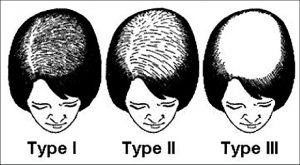The Ludwig hair loss scale illustrates progressive hair loss patterns in women. It defines several common types of hair loss patterns associated with female pattern baldness and can help you determine your level of hair loss. It is useful for purposes of diagnosis and discussion and can help you and your doctor determine next steps.
In sum, Type 1 is mild, Type 2 is moderate and Type 3 is extensive.

You may have a hunch where you fall on the Ludwig hair loss scale. The good news is that if you suffer from the effects of female pattern baldnessand it bothers you, chances are high we can help.
The Ludwig Scale and Treatment Options
If you are a woman experiencing early signs of hair loss, medications such as Rogaine for women can have a significant long-term impact on helping you keep the hair you have. Platelet rich plasma (PRP) treatment has also been shown to be effective for treating hair loss in women.
You may also be a viable candidate for a hair restoration procedure. It can either be performed by follicular unit extraction (FUE) where hair follicles are removed one-by-one from the donor area or by a strip harvest from the donor area where the hair is more robust and plentiful, then “planted” in the thinning areas. This can be an extremely effective treatment for many women experiencing female pattern baldness. This type of treatment is 100% natural and safe.
It is very important for any woman who is experiencing hair loss to have an accurate diagnosis made by a board-certified physician to determine the cause. Any underlying medical condition must be ruled out before any treatment can be pursued.
If your hair loss does not seem related to the Ludwig hair loss scale patterns, you may be suffering from traction alopecia, inflammatory conditions, or hair loss due to scarring due to injury or cosmetic procedures. At the La Mesa Hair Restoration Center, we are also experts at addressing these common types of hair loss in women.